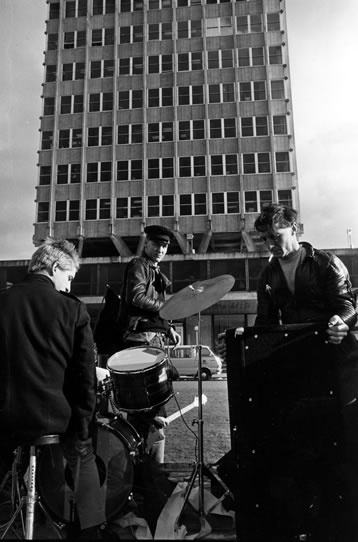
Riot 111 is set up on the back of a truck outside Avalon studios. Lead singer Void is pictured second from left.
Anarchy in the Hutt Valley
Avalon television studios, at that time the nerve centre for local television, faced an unusual protest in 1982 over the alleged banning of a New Zealand music video.
One Thursday in July, staff rushed to the window to see punk rockers Riot 111 playing on the back of a truck, powering their home-grown buzz-saw sound with a generator.
The Wellington-based band were protesting Television New Zealand's (TVNZ) refusal to screen the video clip for their single 'Writing on the wall' on Radio with pictures, the only locally broadcast video show. The song included the line ‘You’re all waiting for 1984, but we all know it’s here’.
Featuring images of clashes between police and protestors during the 1981 Springbok rugby tour of New Zealand, the video was rejected for its ‘inference and recreation of police violence’. Riot 111 called the decision ‘stupid and dangerous censorship’.
As the band blazed away at high volume at the front of the Avalon studios, staff lobbed toilet rolls from upstairs windows. Punk supporters painted ‘Remember Riot 111’ in blue across the front lawn and hoisted the A for Anarchy banner on the flagpole.
Riot 111 had been closely involved with the Springbok tour protests. Their first single, '1981', borrowed from the famous 'Ka mate' haka and the 'Amandla' (Freedom) chant universally adopted by local tour marchers.
The band did its own recordings. Like those of other garage bands of the day, the quality wasn't the best. After the Avalon protest made the front page of Wellington newspaper the Dominion, TVNZ's head of entertainment said he would have screened the clip ‘if the music and sound recording had been of a higher standard’.

The rejection letter from TVNZ’s head of entertainment that sparked the protest.

The Dominion carried a front page report of the protest.

Community contributions